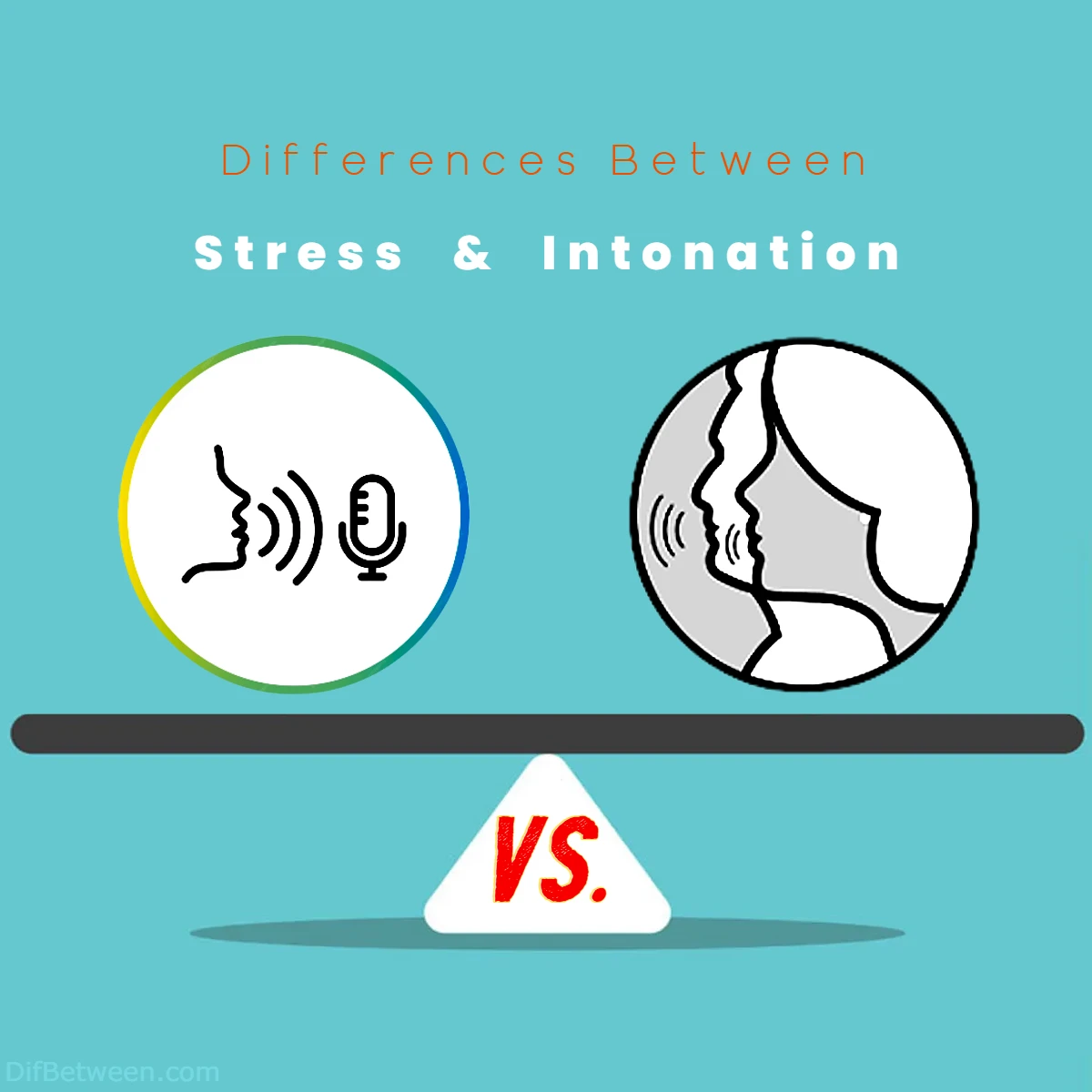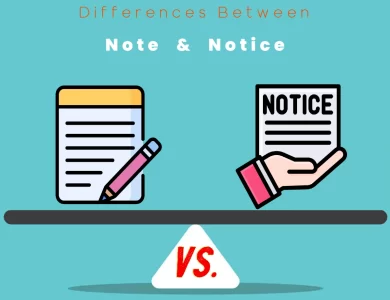
| Aspect | Stress | Intonation |
|---|---|---|
| Definition | Emphasis on specific syllables or words within a sentence. | Melodic rise and fall of pitch during a sentence or phrase. |
| Scope | Applies at the word or syllable level. | Encompasses entire sentences or phrases. |
| Primary Focus | Emphasizing words for meaning and clarity. | Conveying sentence type, emotions, and attitude. |
| Sound Characteristics | Variations in pitch, loudness, and duration. | Variations in pitch contour, pitch range, and patterns. |
| Example | “I want a BAnana.” (emphasis on “BAnana”) | “You’re coming to the party?” (rising pitch on “party”) |
| Language Examples | English, Spanish, Russian, Mandarin, etc. | English, Spanish, Russian, Mandarin, etc. |
| Function | – Conveys meaning changes in words or phrases. | – Indicates sentence types (questions, statements). |
| – Expresses emotions and attitudes. | – Conveys emotions (excitement, surprise, sadness). | |
| – Highlights critical information. | – Clarifies nuances of meaning. | |
| Application | – Used within words or phrases for emphasis. | – Applied across sentences or phrases for tone. |
| – Can change the meaning of a sentence. | – Differentiates question types (yes-no, wh-questions). | |
| – Used in languages with stress patterns (e.g., English). | – Used to express various emotions (happy, sad, surprised). |
In the mesmerizing world of linguistics, where words dance to the rhythm of expression, two indispensable elements take center stage: stress and intonation. These linguistic tools, akin to the conductor’s baton in a symphony, wield the power to transform mere words into a mesmerizing melody of meaning.
Differences Between Stress and Intonation
The main differences between Stress and Intonation lie in their linguistic functions and application. Stress involves emphasizing specific syllables or words within a sentence, typically affecting individual word meanings and conveying emotions or importance. In contrast, Intonation deals with the melodic rise and fall of pitch during a sentence or phrase, indicating sentence types (such as questions or statements), conveying emotions, and adding nuanced shades of meaning to the spoken language. Understanding these distinctions is crucial for effective communication, as they enable speakers to convey not just words but also emotions and intent, making conversations richer and more engaging.
Defining
Stress: The Rhythmic Beat of Language
Stress, in linguistic terms, refers to the emphasis placed on a particular syllable or word within a sentence. It’s like the musical beat of language, where some notes are played louder and with more emphasis than others. Stress gives words their rhythm and helps to convey the intended meaning in a sentence.
How Stress Works?
In English and many other languages, stress typically involves varying the pitch, loudness, and duration of a particular syllable or word. It’s like highlighting a word in bold or underlining it to draw attention. When a syllable or word is stressed, it stands out from the surrounding syllables, making it more prominent.
Let’s take the word “banana” as an example. In the sentence “I want a banana,” the stress falls on the second syllable, ‘ba-NA-na.’ When you say this sentence, you’ll naturally emphasize the ‘NA’ part, making it sound like “I want a BAnana.”
Functions of Stress
Stress serves several essential functions in language:
- Conveying Meaning: Stress can change the meaning of a word or a sentence. For instance, consider the words “permit” and “permit.” The stress on different syllables distinguishes between the noun (a document) and the verb (to allow).
- Expressing Emotions: Stress can convey emotions and attitudes. A stressed word can show excitement, urgency, or importance, while unstressed words may indicate neutrality or casualness.
- Highlighting Information: Stress helps listeners identify the most critical information in a sentence. It guides them to focus on the emphasized words, aiding comprehension.
Intonation: The Melody of Speech
Intonation, on the other hand, is the melodic aspect of speech. It deals with the rise and fall of pitch (intonation contour) during a sentence or phrase. Think of it as the musical tune that accompanies the lyrics. Intonation adds layers of meaning, such as questions, statements, or emotions, to spoken language.
How Intonation Works?
Intonation is not limited to individual syllables or words but rather encompasses entire sentences or phrases. It involves variations in pitch, pitch range, and pitch patterns. These variations create a musical quality to speech, allowing us to convey complex ideas and emotions beyond the mere words used.
For instance, the intonation pattern of a question typically involves a rising pitch towards the end of the sentence. Compare these two sentences:
- Statement: “You’re coming to the party.”
- Question: “You’re coming to the party?”
In the question, the rising intonation on “party” signals the request for confirmation or information.
Functions of Intonation
Intonation plays a crucial role in communication, serving various functions:
- Indicating Sentence Type: Intonation helps differentiate between statements, questions, commands, and exclamations. The rise or fall in pitch at the end of a sentence conveys its type.
- Expressing Emotions: Just like stress, intonation expresses emotions and attitudes. A happy statement and a sad statement may have different intonation contours, conveying distinct emotional tones.
- Clarifying Meaning: Intonation can change the meaning of a sentence. Consider the sentence “I didn’t say she stole the money.” Different intonation patterns on each word can produce six different interpretations, emphasizing different elements of the sentence.
Key Differences between Stress and Intonation
Now that we’ve defined stress and intonation, let’s explore the key differences between these two essential elements of language:
| Aspect | Stress | Intonation |
|---|---|---|
| Definition | Emphasis on specific syllables or words within a sentence. | Melodic rise and fall of pitch during a sentence or phrase. |
| Scope | Applies at the word or syllable level. | Encompasses entire sentences or phrases. |
| Primary Focus | Emphasizing words for meaning and clarity. | Conveying sentence type, emotions, and attitude. |
| Sound Characteristics | Variations in pitch, loudness, and duration. | Variations in pitch contour, pitch range, and patterns. |
| Example | “I want a BAnana.” (emphasis on “BAnana”) | “You’re coming to the party?” (rising pitch on “party”) |
Complementary Roles
One important thing to note is that stress and intonation are not mutually exclusive; they often work in tandem to create rich and nuanced communication. Stress can be thought of as the backbone of a sentence, providing clarity and conveying the most crucial information. Intonation, on the other hand, adds the emotional and grammatical layer, shaping the overall meaning of the sentence.
For example, consider the sentence “I can’t believe you’re coming to the party!” In this sentence, the stress falls on “believe” and “party,” emphasizing the speaker’s disbelief and the event’s significance. The rising intonation on “party” adds a sense of excitement or surprise, while the falling intonation on “you’re coming” signifies the speaker’s statement rather than a question.
Real-World Examples
To better understand the practical implications of stress and intonation, let’s explore some real-world examples where these elements play a crucial role.
Stress in Word Differentiation
Stress can completely change the meaning of a word. Let’s examine a few examples:
- Object vs. Verb: Consider the word “record.” When you stress the first syllable, it becomes a noun, referring to a physical object used for recording. When you stress the second syllable, it becomes a verb, meaning to capture or document something. So, “RE-cord” is different from “re-CORD.”
- Content vs. Contest: Similarly, “CON-tent” refers to the substance or material within something, while “con-TEST” relates to a competition. Stressing different syllables clarifies their distinct meanings.
- Import vs. Import: In the sentence “I need to im-PORT these goods,” the stress on the second syllable indicates the action of importing. However, when you say “This is an IM-portant matter,” the stress on the first syllable highlights the significance of the matter.
Intonation in Questions
Intonation is crucial in conveying questions and seeking information or confirmation. Let’s explore a few question intonation patterns:
- Rising Intonation for Yes-No Questions: In English, yes-no questions typically have rising intonation at the end. For instance, “Are you coming to the party?” The rising pitch on “party” indicates that the speaker is seeking a yes-or-no answer.
- Falling Intonation for Wh-Questions: Wh-questions (who, what, when, where, why, how) often have a falling intonation at the end. For example, “Where are you going?” The falling pitch on “going” signals that the speaker is asking for specific information.
- Intonation for Politeness: Sometimes, intonation can convey politeness or a softer request. For instance, “Could you please pass the salt?” The rising intonation on “salt” suggests a polite request rather than a command.
Stress and Intonation in Emotion Expression
Both stress and intonation are powerful tools for conveying emotions in speech. Here are a few examples:
- Excitement: When someone is excited, their speech often involves increased stress and rising intonation. For instance, “I can’t believe I won the lottery!” The stress on “believe” and the rising pitch on “lottery” express the excitement of the speaker.
- Sadness: In contrast, sadness can be conveyed through reduced stress and falling intonation. For example, “I’m so sorry for your loss.” The reduced stress on “sorry” and the falling pitch on “loss” convey empathy and sympathy.
- Surprise: Surprise can be indicated by a combination of stress and intonation. “You got me a birthday gift!” The stress on “got” and the rising pitch on “gift” convey the unexpected nature of the event.
Practical Tips for Mastering
Now that you understand the distinctions between stress and intonation, here are some practical tips to help you use them effectively in your communication:
For Mastering Stress:
- Identify Key Words: Determine the most important words in your sentences and apply stress to them. This will guide your listener’s understanding of the message.
- Practice Pronunciation: Pay attention to how native speakers stress words in sentences. Mimic their pronunciation to improve your stress patterns.
- Use Stress for Emphasis: When you want to emphasize a point or express strong emotions, use stress strategically. Remember that stress can change the meaning of a sentence.
For Mastering Intonation:
- Listen Actively: Pay close attention to how native speakers use intonation to convey different sentence types and emotions. Practice mimicking these patterns.
- Record Yourself: Record your own speech and listen for intonation patterns. This can help you identify areas for improvement.
- Experiment with Pitch: Play with pitch variations in your speech to convey different emotions and intentions. Practice using rising and falling intonation appropriately.
Advanced Techniques for Perfecting
In our previous discussion, we explored the fundamentals of stress and intonation and their crucial roles in effective communication. Now, let’s delve deeper into these linguistic tools and discover advanced techniques to master them.
Fine-Tuning Stress Patterns
While basic stress patterns are essential, mastering stress for optimal communication requires a more nuanced approach. Let’s explore some advanced techniques for fine-tuning your stress patterns:
Contextual Awareness
Consider the broader context of a conversation or speech. Sometimes, stress patterns can change based on the preceding or following words. For instance, in the sentence “She will record the song,” “re-CORD” is stressed because it’s a verb. However, in the sentence “This is a RE-cord of the song,” “RE-cord” is stressed because it’s a noun. Contextual awareness helps you choose the appropriate stress pattern.
Sentence Rhythm
Think of your speech as a rhythmic dance. Varying stress patterns can create a natural rhythm in your sentences. Experiment with different stress patterns to achieve the desired rhythm. For example, in storytelling, you might use a regular stress pattern to establish a calm narrative. In contrast, for an exciting event, you could use irregular stress patterns to create anticipation and suspense.
Emphasizing Nuances
Advanced speakers use stress to convey subtle nuances of meaning. For instance, consider the word “interesting.” By stressing different syllables, you can express different shades of meaning. “IN-ter-est-ing” may indicate genuine interest, while “in-TER-est-ing” might suggest skepticism.
Intonation Mastery
Intonation, with its melodic rise and fall, adds layers of meaning and emotion to your speech. Perfecting intonation involves not only understanding its basic functions but also using it creatively. Let’s explore advanced techniques for mastering intonation:
Emotional Resonance
Advanced speakers use intonation to evoke specific emotions in their audience. They do this by matching their intonation contour with the intended emotional tone. For instance, a heartfelt apology might have a falling intonation to convey sincerity, while a sarcastic comment may have a rising intonation to indicate insincerity.
Subtle Shifts
Intonation can also be used for subtle shifts in meaning or emphasis. Experiment with slight variations in pitch contour to highlight specific words or ideas. A gentle rise in pitch can indicate a subtle question or uncertainty, while a sharp rise can convey surprise or disbelief.
Pacing and Pauses
The timing of your intonation can greatly impact communication. Advanced speakers master the art of pacing and using pauses effectively. Pauses can add dramatic effect, allowing the listener to absorb the message. For instance, in a suspenseful story, a well-timed pause before a crucial revelation can heighten anticipation.
Stress and Intonation in Multilingualism
For individuals fluent in multiple languages, understanding the differences in stress and intonation patterns among languages becomes essential. Here are some advanced considerations:
Code-Switching
Code-switching involves seamlessly shifting between languages during a conversation. Mastery of stress and intonation in each language is crucial for clear and effective code-switching. In some cases, maintaining the stress and intonation patterns of a particular language can enhance authenticity and comprehension.
Language Fusion
Advanced multilingual speakers often blend stress and intonation patterns from different languages for artistic or rhetorical purposes. This fusion can create unique and memorable speech patterns. However, it requires a deep understanding of both languages’ stress and intonation systems to ensure effective communication.
Using Stress and Intonation in Public Speaking
Public speaking demands a high level of mastery over stress and intonation. Here are advanced techniques for leveraging these tools in public speaking:
Strategic Stress
In persuasive or informative speeches, strategically place stress on key points or ideas to make them memorable. Repeatedly stressing a central message can reinforce its importance in the audience’s mind.
Dynamic Intonation
Public speakers use intonation to maintain audience engagement. Varying intonation contours keeps the speech dynamic and prevents it from becoming monotonous. Transition smoothly between rising and falling intonation to maintain audience interest.
Emotional Impact
Powerful speeches often require conveying strong emotions. Advanced public speakers use stress and intonation to express their emotions authentically. Practice emotive speeches with a focus on matching stress and intonation to the intended emotional tone.
Tools and Resources for Improvement
To advance your skills in stress and intonation, consider these tools and resources:
Speech Coaches
Working with a speech coach or language tutor can provide personalized guidance and feedback on your stress and intonation patterns. They can identify areas for improvement and help you refine your skills.
Language Learning Apps
Many language learning apps offer pronunciation and speech analysis features. These can be valuable tools for practicing stress and intonation in various languages.
Video and Audio Recordings
Record your speeches or conversations and review them critically. Listen for instances where you could have applied stress or intonation more effectively. Self-assessment is a powerful tool for improvement.
Phonetic Transcriptions
Use phonetic transcriptions of words and sentences to understand the stress patterns in different languages. This can help you grasp the nuances of stress placement.
Conclusion
Stress and intonation are the dynamic duo of effective communication, offering advanced speakers powerful tools for conveying meaning, emotion, and nuance. By fine-tuning your stress patterns and mastering intonation, you can elevate your communication skills to new heights. Whether you’re a public speaker, multilingual communicator, or simply looking to express yourself more effectively, these advanced techniques will help you become a compelling and impactful speaker. So, go ahead and explore the rich world of stress and intonation, and let your words resonate with power and grace.
FAQs
Stress in language refers to the emphasis placed on specific syllables or words within a sentence. It involves variations in pitch, loudness, and duration, highlighting certain elements to convey meaning, emotions, or importance.
Intonation is the melodic rise and fall of pitch during a sentence or phrase. It helps convey sentence types (like questions or statements), express emotions, and add subtle nuances to spoken language beyond the words themselves.
Stress primarily applies at the word or syllable level, focusing on emphasizing individual elements within a sentence. In contrast, intonation encompasses entire sentences or phrases, shaping the overall melody and tone of the spoken language.
Stress serves several functions, including changing the meaning of words or sentences, expressing emotions and attitudes, and highlighting critical information to aid comprehension.
Intonation is crucial for indicating sentence types (questions, statements, exclamations), expressing emotions, clarifying nuances of meaning, and conveying attitudes, all of which contribute to effective communication.
Yes, stress and intonation often complement each other. Stress provides clarity and meaning at the word level, while intonation shapes the overall tone and emotional context of sentences. They work together to create engaging and expressive communication.
Mastery of stress and intonation enhances communication by allowing speakers to convey meaning, emotions, and intent effectively. It leads to clearer and more engaging conversations, making it easier to connect with others on a deeper level.
No, stress and intonation patterns vary from one language to another. Each language has its own rules and conventions for stress and intonation, contributing to the diversity of linguistic expression worldwide.
Read More:
Contents
- Differences Between Stress and Intonation
- Defining
- Key Differences between Stress and Intonation
- Real-World Examples
- Practical Tips for Mastering
- Advanced Techniques for Perfecting
- Fine-Tuning Stress Patterns
- Intonation Mastery
- Stress and Intonation in Multilingualism
- Using Stress and Intonation in Public Speaking
- Tools and Resources for Improvement
- Conclusion
- FAQs






